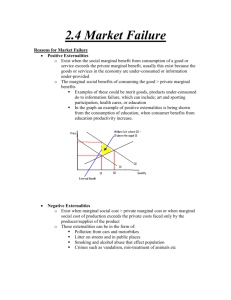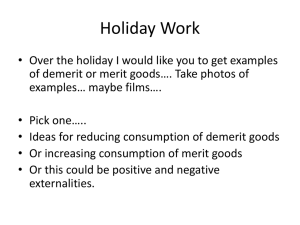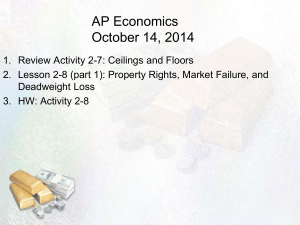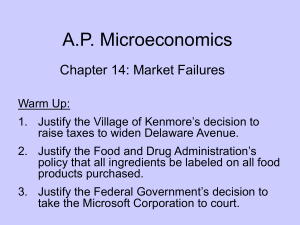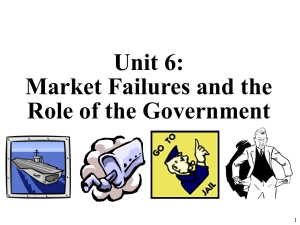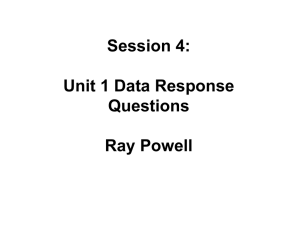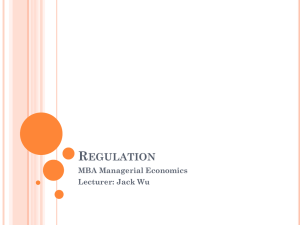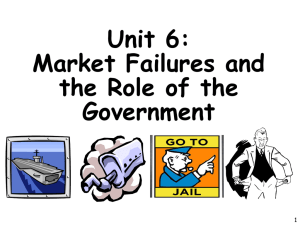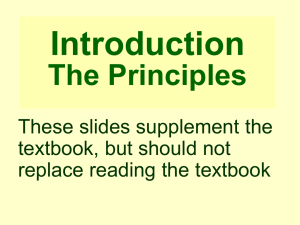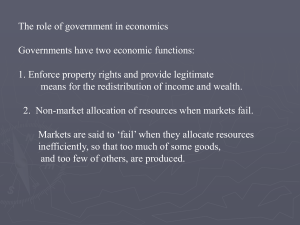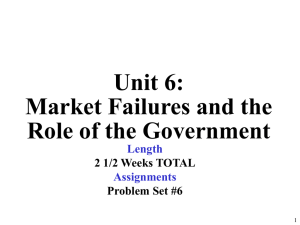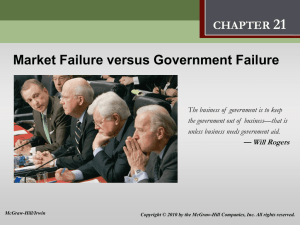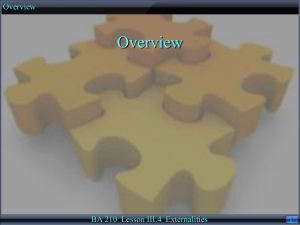1.4 Market Failure
advertisement
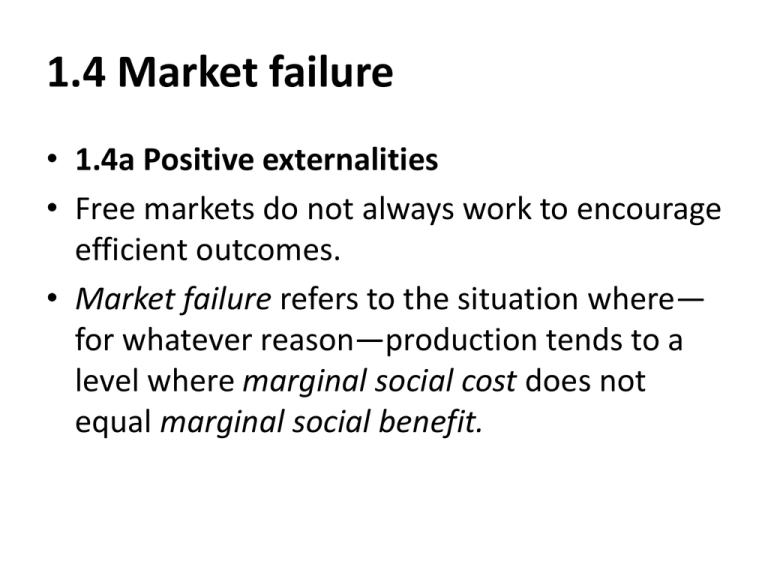
1.4 Market failure • 1.4a Positive externalities • Free markets do not always work to encourage efficient outcomes. • Market failure refers to the situation where— for whatever reason—production tends to a level where marginal social cost does not equal marginal social benefit. A merit good is a good that provides benefits to society beyond what is enjoyed by the buyer. We call those benefits a positive externality. A good example is a flu shot. If you decide to receive a flu shot, you are not only helping yourself avoid illness, you are also helping your friends and relatives avoid catching the flu from you, and they get that for free. If people have to pay the market price for a flu shot, many might decide the benefit is not worth the cost, and flu shots would be less than is best for the community as a whole. As with all merit goods, flu shots would be under-provided in a free market. Can you think of any other merit goods? In the diagram below, free market demand is considered to be the marginal private benefit that consumers gain from the good or service. When the marginal private benefit is combined with the external benefits, this is called marginal social benefit. The free market equilibrium is where marginal private benefit = marginal private cost is indicated by Pp and Qp. If we presume that the supply curve represents marginal private cost = marginal social cost, then the relationship would be MSB > MSC. However, the area directly above the private market equilibrium (indicated by the arrow which points towards the MSB curve) is the area of the positive externality and the spillover benefits are reflected in the marginal social benefit curve. If we presume the marginal private cost to be equal to the marginal social cost, then the private market transaction would result in MSB > MSC. This is a short hand way of explaining a good or service with positive externalities. Government intervention can minimize the under-provision of merit goods by subsidizing production or consumption, or by providing the good socially. Merit goods v. public goods Sometimes the government provides goods that the market will not and these are known as public goods. Public goods are characterized by several factors: Nonrivalry: This means that consumption by one person does not reduce the amount available to be consumed by another person. My use of a road does not reduce others ability to use the road. Nonexcludability: This means that nobody can be excluded from consuming the good or service. Streetlights are a good example. Free – rider problem: The challenge for public goods is that people who don’t pay for them get a “free ride” by consuming the good or service for which others pay. An example might be a public park in a large city that is paid for by the taxes of wealthy income earners but used by less well off residents who may not pay any taxes at all. Lack of public goods can be considered to be a form of market failure, as providers cannot charge directly for their use and consumers know that they cannot be prevented from using the good even if they don’t pay. 1.4b Negative Externalities • Demerit goods are always overprovided in a free market because negative externalities are created, meaning that social costs are greater than production costs. Here we see that a free market will oversupply the good because external costs are not considered. The market equilibrium is where marginal private benefit = marginal private cost is indicated by Pp and Qp. However, the area directly above the private market equilibrium (indicated by the arrow which points towards the MSC curve) is the area of the negative externality and the spillover costs are reflected in the marginal social cost curve. If we presume the marginal private benefit to be equal to the marginal social benefit, then the private market transaction would result in MSC > MSB. This is another way of explaining a good or service with negative externalities. The most common examples of negative externalities are air and water pollution, where firms harm others by discarding their waste without consequence. Negative externalities harm others by creating health problems or an unpleasant environment. Smaller examples include leaving trash in the park, playing loud music that disturbs you neighbors, or smoking in a restaurant when others are trying to enjoy a good meal. Governments try to minimize negative externalities through legislation or tax, either outlawing the production of certain pollutants, or taxing production of goods that create pollution, increasing costs and decreasing production. Another government response to pollution problems is to create a market for pollution permits. Because firms are free to buy and sell their permission to pollute, the permits are known as tradable permits. Allowing companies to sell their permits encourages new technologies for pollutionfree production and ensures that the permits end-up in the hands of companies that need them most. Is there another way to mitigate these externalities? The Coase Theorem was developed to provide an alternative to government remedies for negative externalities. For this to work there are several conditions that need to be in place: - Property ownership must be easily defined so that responsibility can be assigned. - The number of parties involved needs to be small. - Negotiating costs must be very small or negligible. Under these conditions, the government’s role is to encourage bargaining between the parties most effected. 1.4c Asymmetric information (HL only) • Asymmetric information is a form of information failure where unequal knowledge is possessed by the parties to a transaction. • The most common area is which we see this is in the area of medicine where patients have limited medical knowledge and the doctor possesses detailed medical knowledge. A situation is created where the producer is telling the consumer what health services he or she should buy. 1.4c Asymmetric information (HL only) • Solutions for these situations usually revolve around government regulations via the legislative process. This means that the government will increase access to information. - The government can require full disclosure of certain information during the negotiating process. - Another solution is for the government to directly provide information to the public. 1.4c Monopoly • Monopoly markets can also lead to market failure, especially when demand is inelastic. Because of the higher revenues available at higher prices, essential goods might be underprovided in a free market. Maximizing profit, a monopoly will charge price P1, meaning that many fewer goods will be sold than where production is efficient, at Q2. For a limited time, monopoly profits are allowed under copyright and patent laws as a way to encourage innovation and invention. In other cases, governments may encourage production by subsidy or direct intervention, buying the good at monopoly prices and selling at a lower price. This sometimes happens with pharmaceuticals that are necessary for the prevention of disease. 1.4d Tragedy of the Commons • Market failure can also occur when property rights are not well established or property is shared—in common—among many users. • Tragedy of the Commons refers specifically to an historical example. Previous to industrialization, it was normal for towns to have an open space available for grazing animals or growing crops. This space was called a commons and citizens were free to use the space as they liked. The tragedy occurs when someone realizes that he can use the land for his own profit, maybe grazing too many cows on the land, generating profit for himself, but destroying the land for other users. Resources that are shared among many users tend to be overused because the cost of the lost resource is very small for the individual, and any revenue generated is likely to overwhelm the cost. Contemporary examples include over-fishing of the oceans, over-hunting of animals leading to possible extinction, and the over-use of clean air and water (pollution).

